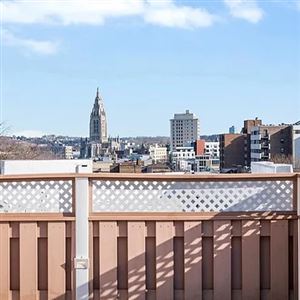Open up any garden book, and one constant in addressing proper landscape design is the consideration of the garden in winter.
Pittsburgh's growing season typically ends by mid-November, with most deciduous trees and shrubs bereft of leaves and herbaceous ornamentals frozen into a pile of mush. Spring can make its appearance in late March or be delayed until mid-April. That leaves four to five months of the year with a landscape reliant on the visual appeal of the silhouette of woody plants, the varied colored palette of coniferous and broadleaf ornamentals, as well as a smattering of perennials with interesting seed heads and berries. Keeping this in mind, the gardener must envision the landscape without the rainbow of colors supplied by flowers, which steal the show from April through October.
Evergreens comprise the bulk of plants with winter interest. Enormous specimens of pine, spruce and hemlock come quickly to mind, but the range of dwarf conifers is vast, both for colorful foliage and interesting texture. Dwarf, as it relates to conifers, is a relative term, considering that a native hemlock tops off at 70 feet tall, while a weeping, dwarf specimen might grow to a height of 10 feet or less. Dwarf conifer foliage ranges from the bright green-yellow of gold thread cypress (Chamaecyparis pisifera 'Filifera Aurea') to the cool silvery blue of grey owl juniper (Juniperus virginiana 'Grey Owl').
Broadleaf evergreens include Rhododendron and Leucothoe species, Japanese pieris (Pieris japonica), blue holly (Ilex x meservae) and boxwood (Buxus). Less common but excellent evergreen choices for the home landscape include sweet box (Sarcococca hookeriana), Japanese plum yew (Cephalotaxus harringtonia) and cherry laurel (Prunus lauroserasus).
Deciduous trees and shrubs can also lend interest to the winter landscape. River birch (Betula nigra) and paperbark maple (Acer griseum) are trees with great-looking bark that fit into the home landscape. The fat, fuzzy buds of magnolia also add interest to the winter garden. Red and yellow twig dogwood (Cornus sericea, C. stolonifera, C. sanguinea and C. alba) provide a shot of color on their bare branches. Berries adorn the boughs of deciduous holly (Ilex verticillata), cotoneasters, Viburnum species and many roses.
Sedum and coneflower do not need to be cut back in the fall. Both look good in the winter garden. Coneflowers offer the added bonus of seeds prized by chickadees. Siberian iris and blackberry lily (Belamcanda chinensis) have interesting seedpods. Ornamental grasses have feathery seadheads and purple Allium christophii flowers senesce into interesting sputnik-like spheres.
The bonus of taking the time to plan for a garden with winter interest is that nearly all of these plants can be cut and arranged to enjoy inside and outside the home over the holidays. A walk through the garden geared toward the quiet beauty of bare branches and winter color from evergreen plants will yield more interesting choices for arrangements than most commercially available greens. Pinecones, moss and evergreen ferns all can make their way into arrangements. For indoor use berries should be firm, but in large outdoor planters fruit-laden branches from crabapple trees can provide interest.
If you intend to enjoy your arrangement indoors, invest in floral foam and tape it into a water-tight container. Any object, from baskets to old garden boots, can be lined with plastic and used for arrangements. Floral foam will hold water and support most cuttings from the garden. Large branches require additional support. The addition of chicken wire, shaped over the top of a container, will provide support for branches over a half inch in diameter.
Needled plants do not require conditioning but will hold up best in a cool location. Experiment with plants to see which do best in arrangements. Hemlock, spruce and blue holly shed their leaves and needles quickly in my experience, so I avoid using them, especially indoors. White and mugo pine, cypress and juniper all hold well for weeks. Broad-leafed evergreens do best if cut and placed in water overnight prior to arranging. Pieris japonica and Leucothoe add a lovely textural contrast to needled plants. Boxwood is prized for its foliage in arrangements and can be used to make topiaries and kissing balls.
Pruning cuts can be made on trees and shrubs by cutting at a 45-degree angle just above a side branch or leaf. Shrub dogwoods with colored stems benefit by thinning cuts; it encourages the growth of bright new shoots. Use loppers or pruners and select older, thicker branches, cutting them at the base of the plant. Bare branches act as "thrillers," anchoring a container laden with greens and providing vertical interest.
A quick look at current retail holiday décor proves that red and green are no longer the only options for Christmas. Just as annuals in the garden should not be the same every year, nor should the color choices for holiday arrangements remain set in stone. Try using a palette of turquoise and silver or copper and lime green this season.
Aesthetics guide the final arrangement. Some gardeners prefer the quiet palette of plants straight from the garden. If you are hungry for more color, get out the spray paint and glitter. Embellishments can run the gamut from naturalistic birds to glittery ornaments. Ribbon choices abound; country plaids or luxurious velvets can be chosen to complement the container or the décor of a room. I am ribbon-challenged, completely incapable of creating beautiful bows. I have found cable ties wonderful for gathering several loops of ribbon, cinching them tightly and plunging the tail of the tie into floral foam. The addition of a cluster of ornaments, or a bit of greens, hides the exposed tie at the center of the bow. Wire ribbon is easy to work with and allows the arranger to create a pleasing line in the floral design.
A well-planned garden, with a mix of evergreen and interesting deciduous plants, can brighten up a gray Pittsburgh winter. It can also provide the bulk of materials you need to deck your halls this season. Except for the glitter, that is.
First Published: December 8, 2012, 5:00 a.m.
















